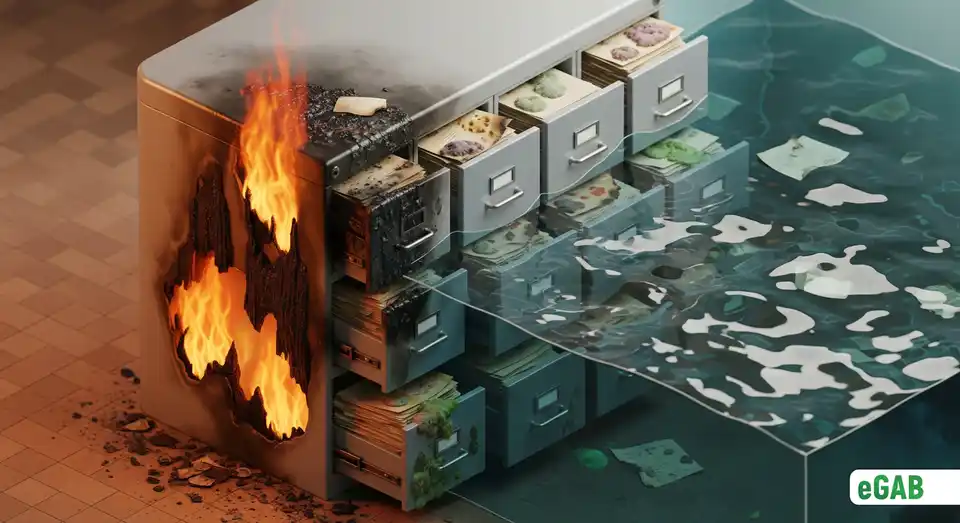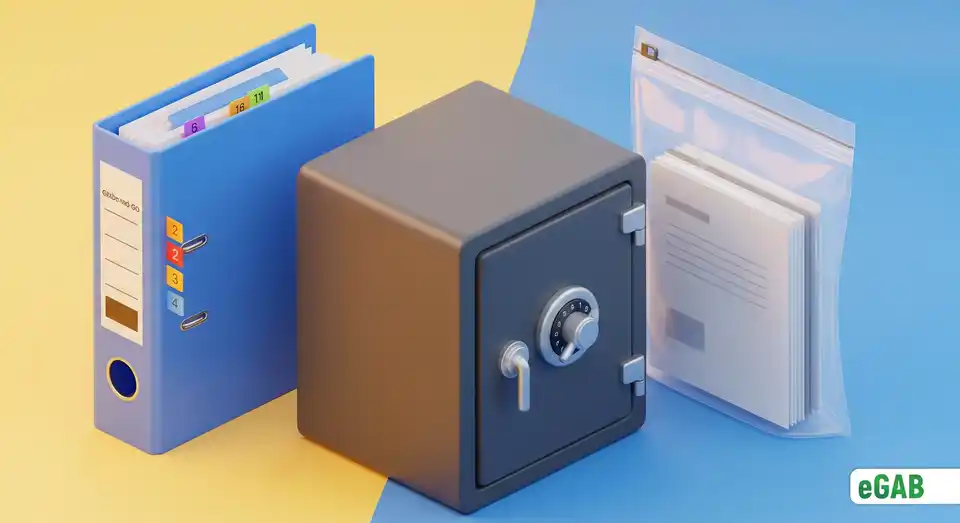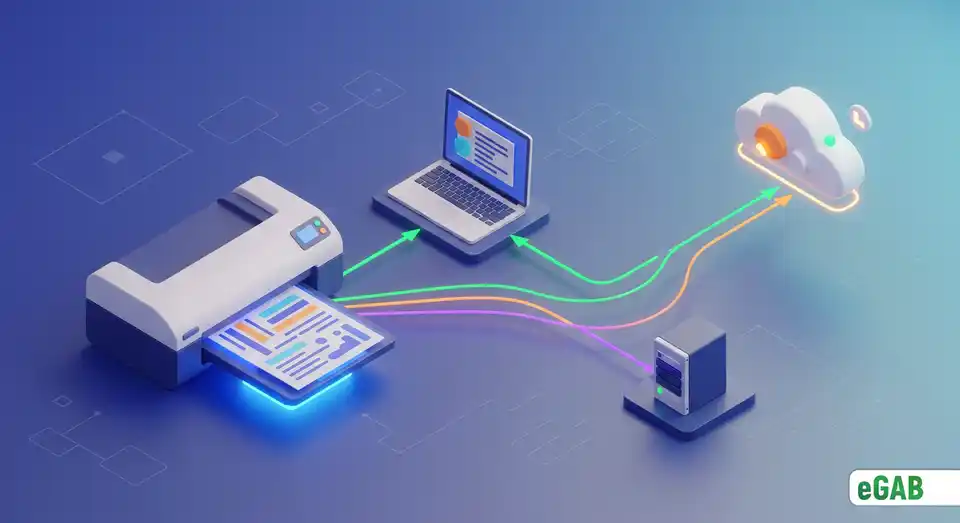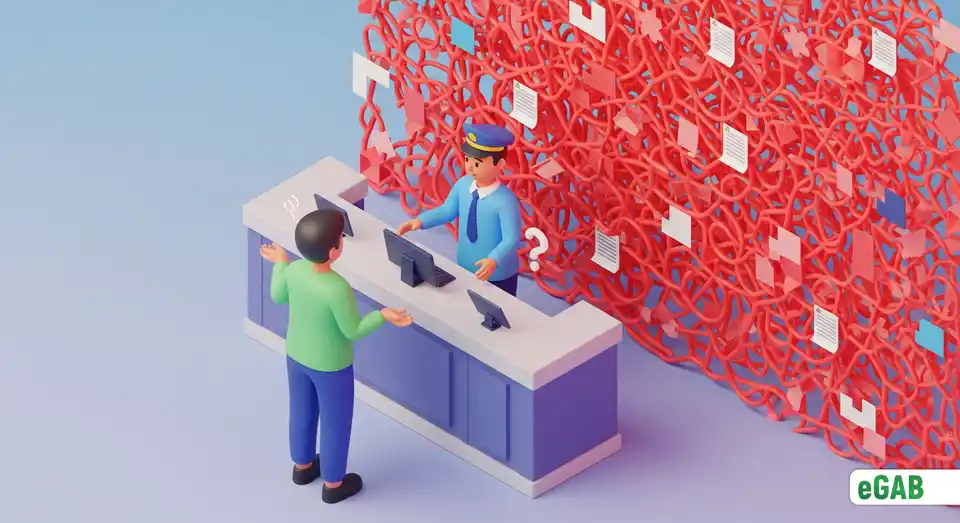Fire, Flood, or Loss: How to Create a Disaster-Proof Document Storage Strategy

 Author:
Artem Grigoriev
Author:
Artem Grigoriev
- Why Are Your Paper Documents at Such High Risk?
- What Are the Best Physical Safeguards for Your Documents?
- How Can Digital Backups Make Your Documents Invincible?
- What Happens When Essential Documents Are Irretrievably Lost?
- How eGAB Offers Intrinsic Disaster Immunity for Your Documents
- Summary: Building Your Invincible Document Fortress
You probably have that one specific spot for your vital records-maybe a shoebox, a folder, or a filing cabinet drawer. It’s where things like your passport, birth certificates, and property deeds live. And you simply trust that they’re safe. But what happens when disaster strikes? Imagine a burst pipe suddenly floods your basement, or even worse, a fire breaks out. Suddenly, that single point of failure could wipe out your life on paper, plunging you into a bureaucratic nightmare.
That’s exactly why you need a disaster-proof document storage strategy . It isn't just a good idea; it's an essential plan for your ultimate peace of mind. A truly resilient system goes far beyond a simple lockbox. It works by combining robust physical safeguards designed to protect against fire and flood with a smart digital backup strategy. This powerful combination makes your information virtually invincible. In this guide, we'll walk you through every step of building that bulletproof system. You’ll learn everything from selecting the right fireproof document storage to assembling a "grab-and-go" binder. We'll also show you how to implement the gold-standard "3-2-1 backup rule" for all your digital files.
📘 This post is part of our comprehensive guide to "The Problems with Paper Documents: A Complete Guide". Explore it to find answers to all your questions ;)
Why Are Your Paper Documents at Such High Risk?
It's easy to think that the filing cabinet in the corner is a safe space, isn't it? But let's be honest: your paper documents are living on borrowed time. So, what are the risks of storing only paper documents? The risk isn't some once-in-a-lifetime disaster. It's a quiet, daily threat hanging over your most important information. Just think about the massive headache of a single misfiled document. It's far from a minor hiccup. According to PricewaterhouseCoopers (PwC) , it costs about $120 just to track down a misplaced file. And to recreate a lost one? That cost skyrockets to an astonishing $220 . This creates a constant, low-level crisis where your critical information can just disappear. That drags down productivity and hits your bottom line right when you can least afford it.
Of course, for any business continuity plan , the real nightmares are fire and flood. Paper is incredibly fragile, and a single disaster can wipe out years of your vital records in a flash. The consequences of losing documents this way are staggering. In fact, FEMA (the Federal Emergency Management Agency) estimates that a shocking 40% to 60% of small businesses never reopen after a major disaster. A huge reason for that is the catastrophic loss of documents. And here's the crucial part: you don't need to be in a flood plain to be at risk. Water damage is incredibly common. In fact, some reports show that a staggering 98% of US basements will experience it at some point. The moment paper gets wet, the clock starts ticking. Preservation experts warn that destructive mold can take hold fast. This leads to irreversible mold damage that makes your documents completely useless. You can get a better sense of the recovery process from the U.S. National Archives guidance on recovering water-damaged materials . And while professional water damage restoration can sometimes save your files, it's an expensive, time-sensitive gamble that's never guaranteed to pay off.
The biggest problem with relying on paper is that it has no backup. It’s a classic single point of failure . Unlike a digital file, you can't just make a copy and save it somewhere else. When a physical document is gone, it's gone for good. Even something as simple as an office move can lead to permanent loss. So can an accidental toss into the recycling bin. This kind of accident can create serious and unexpected legal or operational problems for you years later.
Why It Matters: The vulnerability of your paper documents isn't a hypothetical problem-it's a direct threat to your financial security and peace of mind. Believing your files are "safe enough" in a cabinet is a huge gamble, and it's one your business can't afford to lose.

What Are the Best Physical Safeguards for Your Documents?
Let's get practical: how do you protect your documents from fire and water? Even if you're aiming to go completely digital, you still need a rock-solid plan for your original physical documents. Protecting documents from fire and flood is the critical first step in your overall strategy. Think of it like building multiple layers of defense against the unexpected. You should design your strategy based on how important a document is and its official legal status. This brings us to a key question: what is the best way to store important documents at home?
For your most irreplaceable originals, you need the absolute best protection you can get. We're talking about crucial vital records like birth certificates, passports, property deeds, and original signed contracts. For these items, nothing beats a certified fireproof and waterproof safe. Investing in dedicated fireproof document storage isn't just an expense-it's an insurance policy for your most critical assets. When you're shopping for a safe, look for one with a UL (Underwriters Laboratories) or Intertek rating. These certifications from independent safety testers guarantee it provides solid protection against both fire and water. A high UL rating for fire resistance is a non-negotiable feature for serious protection. You'll want to keep this fireproof safe on-site-it's your personal fortress. It's designed to withstand the absolute worst-case scenario. Looking for a more accessible and affordable first line of defense? There are other great options. For less critical papers, for example, consider using sealed waterproof document bags or sturdy plastic containers. While they won't survive a fire, they can easily protect your files from a common mishap like a burst pipe or minor flood.
This leads to a common question: should I keep my important documents in a safe deposit box? For maximum security against disasters at your home or office, you simply can't beat off-site document storage . This strategy protects you from localized threats like fire or theft. Renting a safe deposit box at a local bank, for instance, gives you a secure, climate-controlled environment that's completely separate from your home or office. But what about emergencies that force you to evacuate in a hurry? A "grab-and-go" binder is an absolute lifesaver. This brings up another key question: what should be in an emergency "grab-and-go" binder? You should keep photocopies of your most vital documents-never the originals!-in a single, portable binder. We're talking about copies of IDs, insurance policies, and bank statements. The ideal grab-and-go binder contents should also include contact info for family, financial institutions, and copies of prescriptions. It's a key part of your disaster recovery plan (your process for getting back to normal after a crisis), and you can grab it in seconds.
Finally, if a disaster strikes, remember that time is your greatest enemy. Professional restoration services can often work what seems like miracles. In fact, experts estimate they can successfully recover up to 90% of fire and water-damaged documents . But there's a catch: they have to start treatment within a critical 24 to 48-hour window. After that, mold and degradation can set in for good.
Try This: Make it your goal to create your "grab-and-go" binder this weekend. It might sound like a big task, but it actually takes less than an hour. It could be the one thing that saves you from weeks of stress during an emergency. Just be sure to include copies of your driver's license, social security card, insurance cards, and the first page of your passport.

How Can Digital Backups Make Your Documents Invincible?
Physical safeguards are a great start, but to make your documents truly invincible, you need to go digital. This is the core of any modern document storage strategy and the absolute key to creating a truly disaster-proof document storage system. The single most effective strategy you can adopt is to digitize all your important records. The simple act of digitizing important documents transforms them from fragile, vulnerable objects into resilient, accessible data. This means scanning them into a high-quality, universally accessible format. For this, we highly recommend PDF/A , which is the official archival standard.
And the best part? This strategy isn't just for disaster recovery-it's also about getting your valuable time back. Relying on traditional paper-based systems is unbelievably inefficient. In fact, research from the Association for Intelligent Information Management (AIIM) clearly shows that clunky document processes cause massive productivity losses. That's precious time your employees waste digging through physical files instead of focusing on their core jobs. This naturally brings up a critical question: is it safe to scan and store documents online? When you do it right, the answer is a resounding 'yes.' Just think about it: how many times have you or a colleague had to recreate a document from scratch, all because the paper original was simply nowhere to be found?
To build a truly robust digital safety net, you just need to follow the industry's gold standard: the "3-2-1 backup rule." So, what is the 3-2-1 backup rule for data? This simple but powerful rule is heavily promoted by cybersecurity experts and serves as your blueprint for invincibility. It's the cornerstone of any effective digital document backup strategy and a complete system for data backup and recovery . You can find it detailed in the U.S. Cybersecurity & Infrastructure Security Agency's ( CISA ) Data Backup Options guide . Here's exactly how it works:
- Keep 3 total copies of your data.
- Store these copies on 2 different types of media. For example, you could use your computer's hard drive and an external hard drive .
- Keep 1 of those copies off-site. The easiest way to do this is with cloud storage , but it's crucial to choose from the many secure document storage solutions available that offer strong encryption and privacy controls.
So, what does this ultimately mean for you? It means you're always covered, no matter what happens. Even if the original paper document is incinerated in a fire or turned to pulp in a flood, you'll still have a perfect, legible copy ready to go. The potential for immediate data recovery is what makes a digital strategy so incredibly powerful. You can access it instantly from anywhere in the world. This comprehensive approach doesn't just eliminate the risk of physical damage; it creates a searchable digital archive and makes your daily workflow much more efficient.
Quick Insight: The "3-2-1 backup rule" is so incredibly effective because it’s designed to protect you from practically every threat imaginable. For instance, a local hard drive failure won't impact your cloud backup. A devastating house fire won't touch the data that's stored safely in a completely different geographic location. It's truly the gold standard for both data protection and for achieving true peace of mind.

What Happens When Essential Documents Are Irretrievably Lost?
Losing a crucial document is so much more than just an inconvenience; it's often the start of a long, frustrating, and expensive bureaucratic nightmare. The consequences of losing documents aren't just theoretical-they create tangible, real-world problems that you have to deal with. The fallout can ripple through your personal and professional life for weeks, if not months.
Let's put this into perspective. If you need to replace a UK passport, for example, the standard online service currently costs £88.50 . As the official GOV.UK passport fees page confirms, it can then take several weeks to arrive. Need a new birth or marriage certificate from the General Register Office in the UK? That’ll be another £12.50 , plus a waiting period of up to 4 working days just for it to be sent out. For more complex credentials, like a university degree, the process is even worse-reissuing it can drag on for more than 10 weeks .
In the business world, the costs tied to document loss are even more painful. When essential business continuity plan documents go missing, your entire operation can grind to a halt. This highlights the true cost of paper, with compelling data from PricewaterhouseCoopers showing it costs companies an average of $220 in labor just to recreate a single lost document from scratch. The loss of critical legal or financial records-such as property deeds, wills, or major contracts-can be absolutely catastrophic. This is what leads people to desperately ask, how can I recover water-damaged paper documents? But often, by the time you're asking, permanent damage has already set in, making professional recovery difficult and costly. This kind of loss can easily spark expensive legal battles waged simply to prove ownership or establish inheritance.
So, how do you create a disaster-proof document strategy? It isn't about one single action, but rather a smart combination of physical protection and secure digital backups. The bottom line is this: without these foundational documents, your life can effectively grind to a halt. You'll face serious and frustrating delays. You might even find yourself completely blocked when you try to apply for a loan, sell a property, claim insurance benefits, or access essential government services. In short, the loss isn't just about a piece of paper; it’s about losing critical access to your own life and assets.
Next Step: Take a moment right now to inventory your five most critical documents. Think: your passport, property deed, will, birth certificate, and social security card. Do you know exactly where the physical originals are right now? And, just as importantly, do you also have a secure digital backup of each one? If the answer to either of those questions is no, make it your top priority this week to get them properly secured.

How eGAB Offers Intrinsic Disaster Immunity for Your Documents
Think about it: a fire, a flood, or even a simple plumbing leak can destroy decades of your most important documents in an instant. Your traditional disaster recovery plan probably relies on backups. But a backup is just a copy, and it's often stored somewhere just as vulnerable as the original. eGAB gives you something much more powerful: intrinsic disaster immunity .
This strength comes from decentralized blockchain technology . Your verifiable documents aren't sitting in a single, vulnerable server room. Instead, the proof of their existence is spread across a secure network in many different locations. This means your documents are naturally immune to local disasters like fire or floods . If one part of the network ever goes down, the record is still perfectly safe and you can access it from anywhere else.
Unlike a backup, a document issued on eGAB is the original, permanent record . There’s no "master copy" to lose, because every computer in the network helps secure the entire system. This creates the ultimate disaster recovery plan by default. You get immediate, global access to every verified document the second you need it, with zero downtime and no chance of data loss . It’s not just a recovery plan-it’s a guarantee of permanent availability .
Takeaway: A backup is just a copy that can be lost or damaged with the original. A decentralized record is the original , built from the ground up to survive. It ensures your critical information isn't just recoverable-it's permanent.

Summary: Building Your Invincible Document Fortress
So, what's the bottom line? To put it simply, relying on that old filing cabinet is like building your house on sand. Your paper documents face a constant barrage of threats, from the slow burn of misfiling to sudden, total devastation. In fact, PwC notes that a single misfiled document can cost a staggering $220 to fix. Then you have disasters like a fire or flood. FEMA warns that up to 60% of small businesses tragically never recover from a crisis like that.
The real problem is that paper is a dangerous single point of failure . In simple terms, that's a component that, if it fails, brings the entire system crashing down. When your paper is gone, it’s gone for good, leaving you to face the costly and bureaucratic nightmare of replacement.
To truly protect yourself, you need a multi-layered defense. This is the very heart of a modern disaster-proof document storage strategy . The first layer is all about smart physical protection. This means securing your most irreplaceable vital records , like property deeds and passports, in a certified fireproof and waterproof safe . It also means diversifying your risk with off-site document storage -a secure safe deposit box at a bank is a perfect example. You also need to be ready for any sudden emergency, which is where a well-stocked "grab-and-go" binder with copies of essential documents comes in. These crucial physical safeguards are your first line of defense against disaster.
But to make your documents truly invincible, you absolutely must go digital. Digitizing important documents is the ultimate disaster-proofing move. Why? Because it transforms fragile paper into resilient data. The undisputed gold standard for this is the "3-2-1 backup rule" . This is the simple practice of keeping 3 complete copies of your data on 2 different types of media (like an external hard drive and the cloud), with 1 copy stored securely off-site. This proven approach to data backup and recovery ensures you're always safe. Even if a fire or flood destroys both the original document and your local backup? You still have a perfect, accessible copy waiting for you. By combining these physical and digital strategies, you move far beyond mere hope. You build a robust system that protects you from nearly any disaster, ensuring your access to your most critical assets is never in doubt.
➡️ What's the next logical step? You've planned for accidental loss; now consider intentional deception. Take a deep dive into the anatomy of modern document forgery.

Is Your Office Drowning in Paper? The Real Estate Cost of Document Storage
Beyond the Shredder: 5 Critical Data Security Risks of Paper Documents
Why Your Paper-Based Office is Failing Your Remote Team
The Environmental Footprint of a Single Paper Document: A 2025 Report
A Practical Guide to Organizing Your Paper Document Archive
